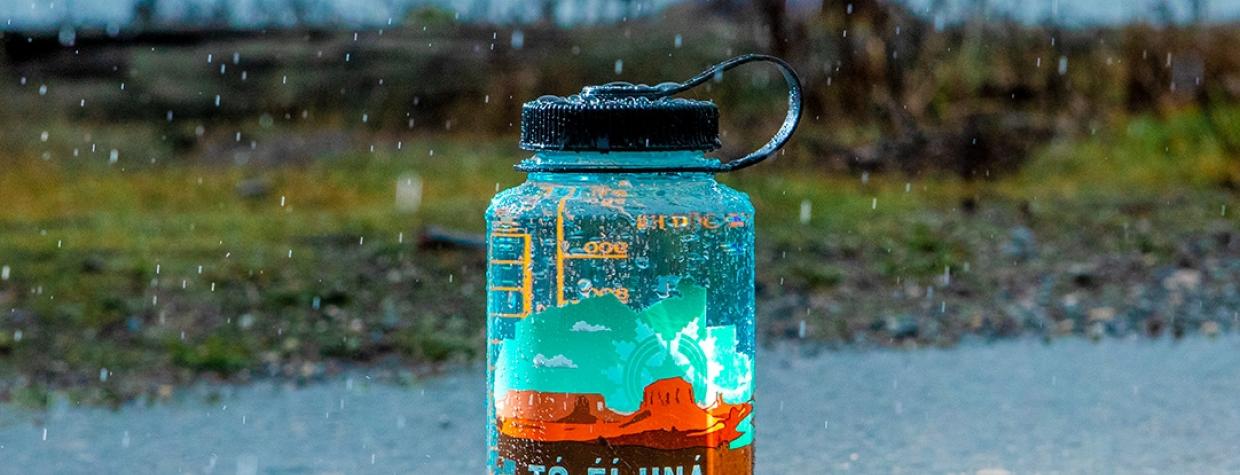Jaden Redhair, a Navajo designer and engineering student at Stanford University, has partnered with Nalgene Outdoor to design a water bottle that supports the Nalgene Water Fund in its efforts to combat the water crisis on the Navajo Nation. The water bottle can be purchased here, and $5 from each purchase will go directly to the Navajo Nation.
We talked with Redhair about his partnership with Nalgene and the importance of bringing awareness to the water crisis that many tribal communities across the nation are facing.
How did this partnership come about?
I did some graphic design work in 2018 for a nonprofit here on the Navajo Nation called Community Outreach and Patient Empowerment program (COPE). I made some posters for them that they hung up around the Navajo Nation that encouraged drinking water. Recently, Nalgene reached out to COPE because they are one of the organizations that helps the Navajo Nation with water disparity. They asked them if they knew of any designers who were Navajo who could work on this. Their first suggestion was me — just because I have done work with them before. From there, Nalgene reached out to me, and that’s how they came to find me.
How did you come up with the design for the bottle, and what does it mean?
When I first started creating the bottle, I actually had three different designs that all had different aspects. I ended up combining them for the final. One design had the outline of the Navajo Nation, which is on the bottle now. The other design was just an illustration of Monument Valley in the background. I decided to use Monument Valley just because it’s one of the more notable monuments on the Navajo Nation, and they asked me to make the design a little more recognizable for people and help them contextualize where geographically they can place the people who are facing these problems. The third design incorporated a Navajo basket. From there, I decided to combine all three. I put Monument Valley inside the shape of the Navajo Nation and also put the Navajo basket inside, just to connect it more to the Navajo people.
Proceeds from the bottle help people on the Navajo Nation with water access. Why is this cause so important?
I think this cause is really important because I see a lot of people on the Navajo Nation, especially in rural areas, that struggle with getting water. Oftentimes you have people who get trucks with huge water barrels that they haul around and drive half an hour to an hour to get water for their homes. They use the water for cooking, drinking and for their livestock. Some of my grandparents live in Sanders, Arizona, and I know they have to haul water to the livestock. I think it’s really important because it creates more access points, so people don’t have to travel as far.
How did you get interested in graphic design?
My dad is actually the graphic design teacher at the high school I attended in Window Rock. I took that class for three years. I learned a lot and really enjoyed it. Even at Stanford, I’m one of the graphic designers for the football team. It’s something I enjoy doing, and it’s a way for me to get out of engineering and get away from the numbers all the time. It’s a good outlet for me to express my creative ideas.
How did your upbringing on the Navajo Nation inspire your art and the creation of this bottle?
I think growing up here has shown me what it really means to come from the reservation. In a way, I wasn’t [only] creating this bottle for Navajo people to use. I was creating this bottle for other people to help contribute to the Navajo Nation. I had to look at it through that lens, which was a little difficult at first, just because I’m used to creating designs that Navajo people see all the time. Now it was the opposite, because I was marketing to people outside the reservation. My upbringing has helped me contextualize what I should and shouldn’t design.
What do you hope people will get out of either purchasing the bottle or just seeing it and gaining awareness about the topic?
I hope what comes out of it is understanding that, across the United States, it’s not just the Navajo Nation that struggles with these issues. Other communities and reservations face issues similar to this. Being at Stanford, I’ve realized that a lot of people who grew up in big cities aren’t really aware of problems like that. When I would speak to them about the problems we face on the Navajo Nation — like people who don’t have running water or electricity — they were amazed. It’s a good way for people outside of the reservations to recognize that these types of problems do exist, not just across the world, but right here in the United States.
How do you hope to use your electrical engineering degree to give back to your community?
I think renewable energy is very important, especially for the Navajo Nation, because there are places that don’t have access to electricity. I think it would be a really good idea to have some things powered by renewable energy. It’s important for us to help push our goals to be focused more on renewable energy because it’s a clean way to provide energy to people who need it.
— Ameema Ahmed, Associate Editor

